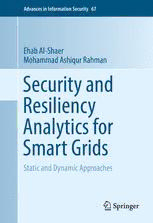Table Of ContentAdvances in Information Security 67
Ehab Al-Shaer
Mohammad Ashiqur Rahman
Security and
Resiliency
Analytics for
Smart Grids
Static and Dynamic Approaches
Advances in Information Security
Volume 67
Serieseditor
SushilJajodia,GeorgeMasonUniversity,Fairfax,VA,USA
Moreinformationaboutthisseriesathttp://www.springer.com/series/5576
Ehab Al-Shaer • Mohammad Ashiqur Rahman
Security and Resiliency
Analytics for Smart Grids
Static and Dynamic Approaches
123
EhabAl-Shaer MohammadAshiqurRahman
DepartmentofSoftwareandInformation DepartmentofComputerScience
Systems TennesseeTechUniversity
UniversityofNorthCarolina,Charlotte Cookeville,TN,USA
Charlotte,NC,USA
ISSN1568-2633
AdvancesinInformationSecurity
ISBN978-3-319-32870-6 ISBN978-3-319-32871-3 (eBook)
DOI10.1007/978-3-319-32871-3
LibraryofCongressControlNumber:2016938524
©SpringerInternationalPublishingSwitzerland2016
Thisworkissubjecttocopyright.AllrightsarereservedbythePublisher,whetherthewholeorpartof
thematerialisconcerned,specificallytherightsoftranslation,reprinting,reuseofillustrations,recitation,
broadcasting,reproductiononmicrofilmsorinanyotherphysicalway,andtransmissionorinformation
storageandretrieval,electronicadaptation,computersoftware,orbysimilarordissimilarmethodology
nowknownorhereafterdeveloped.
Theuseofgeneraldescriptivenames,registerednames,trademarks,servicemarks,etc.inthispublication
doesnotimply,evenintheabsenceofaspecificstatement,thatsuchnamesareexemptfromtherelevant
protectivelawsandregulationsandthereforefreeforgeneraluse.
Thepublisher,theauthorsandtheeditorsaresafetoassumethattheadviceandinformationinthisbook
arebelievedtobetrueandaccurateatthedateofpublication.Neitherthepublishernortheauthorsor
theeditorsgiveawarranty,expressorimplied,withrespecttothematerialcontainedhereinorforany
errorsoromissionsthatmayhavebeenmade.
Printedonacid-freepaper
ThisSpringerimprintispublishedbySpringerNature
TheregisteredcompanyisSpringerInternationalPublishingAGSwitzerland
Thewholeofscienceisnothingmorethana
refinementofeverydaythinking.
(cid:2)AlbertEinstein
Preface
Driven by the rapid advancement of technology and the growing need of business
requirements,cybercommunicationsareembeddedinmanyphysicalsystems.The
integrationofcyberandphysicalcapabilitiesleadstothecreationofmanyapplica-
tions with enormous societal impact and economic benefit. The emerging systems
that connect the cyber-world of computing and communications with the physical
world are cyber-physical systems (CPS). Operations are monitored, analyzed, and
controlled in CPS using cyber systems that interconnect physical components.
Many CPS are defined as critical infrastructures due to their national importance.
According to the U.S. Department of Homeland Security, “Critical infrastructures
aretheassets,systems,ornetworks,whoseincapacitationordestructionwouldhave
a debilitating effect on security, national economic security, national public health
orsafety”.Anydamageorunavailabilityofsuchacriticalinfrastructureoftenhasa
massiveandbroaderimpact.
This book targets a state-of-the-art important concern of protecting critical
infrastructures like smart grids. The work presents various static and dynamic
security analysis techniques that can automatically verify smart grid security and
resiliency and provably identify potential attacks in a proactive manner. These
techniques serve three major security and resiliency analysis objectives. The first
objective is to formally verify the compliance of smart grid configurations with
the security and resiliency guidelines. More specifically, a formal framework is
presented thatverifies thecompliance ofthe advanced meteringinfrastructureand
supervisory control and data acquisition system with the security and resiliency
requirements,andgeneratesremediationplansforpotentialsecurityviolations.The
second objective is the formal verification of the security and resiliency of smart
grid control systems. In this respect, a formal model is presented that analyzes
attackevasionsonstateestimation,acorecontrolmoduleofthesupervisorycontrol
system in smart grids. The model identifies attack vectors that can compromise
state estimation. This part also includes risk mitigation techniques that formally
synthesizeproactivesecurityplansthatmakesuchattacksinfeasible.Thelasteffort
discussesthedynamicsecurityanalysisforsmartgrid.ItisshownthatAMIbehavior
canbemodeledusingeventlogscollectedatsmartcollectors,whichinturncanbe
vii
viii Preface
verified using the specification invariants generated from the configurations of the
AMIdevices.
Although the focus of this book is the smart grid security and resiliency, the
presented formal analytics are generic enough to be extended for other cyber-
physical systems, especially which are involved with industrial control systems
(ICS). Therefore, industry professionals and academic researchers will find this
bookasanexceptionalresourcetolearntheoreticalandpracticalaspectsofapplying
formalmethodsfortheprotectionofcriticalinfrastructures.
Unliketheexistingbooksonthesmartgridsecuritythatmostlydiscussvarious
security issues and corresponding challenges, this book offers unique solutions
addressing these challenges. The book covers novel techniques which can auto-
matically,provably,andefficientlyanalyzethesecurityandresiliencyofthesmart
grids. The distinct features included in this book are formal modeling of smart
grid configurations, proactive and noninvasive verification of smart grid security
and resiliency properties, identification of potential threats, and corresponding
mitigations. This book includes various illustrative case studies and extensive
evaluation results demonstrating the efficacy of the formal techniques. We expect
this book will maximize reader insights into theoretical and practical aspects of
applyingformalmethodsfortheprotectionofcriticalinfrastructures.
Charlotte,NC,USA EhabAl-Shaer
Cookeville,TN,USA MohammadAshiqurRahman
February2016
Acknowledgements
Special thanks to Dr. Rajesh Kavasseri (North Dakota State University, USA),
Dr. Rakesh Bobba (Oregon State University, USA), Dr. Padmalochan Bera (IIT
Bhubaneswar,India),andMuhammadQasimAli(GoldmanSachs,USA)fortheir
preciousinputstothistext.
We also want to thank Susan Lagerstrom-Fife, Editor, Computer Science,
Springer,USAforhersupportandadviceonthisbook.Wewouldalsoliketothank
JenniferMalat,AssistantEditor,Computerscience,Springer,USAforherefforts.
ix

